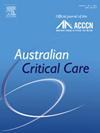Nutrition practices in Australia and New Zealand in response to evolving evidence: Results of three point-prevalence audits
IF 2.6
3区 医学
Q2 CRITICAL CARE MEDICINE
引用次数: 0
Abstract
Background
The Augmented versus Routine Approach to Giving Energy Trial (TARGET) was a 4000-patient trial in which augmented enteral calorie dose did not influence outcomes.
Aim
We aimed to quantify practice change following TARGET.
Methods
Three single-day, prospective, multicentre, point-prevalence audits of adult patients receiving enteral nutrition (EN) in participating Australian and New Zealand intensive care units at 10:00 AM were conducted: (i) 2010 (before conducting TARGET); (ii) 2018 (immediately before publishing TARGET results); and (iii) 2020 (2 years after TARGET publication). Data included baseline characteristics, clinical outcomes, and nutrition data. Data are n (%), mean ± standard deviation, or median [interquartile range]. Differences in enteral calorie prescription between 2018 and 2020 were compared using the Mann–Whitney test.
Results
The percentage of patients receiving EN (2010 42%, 2018 38%, 2020 33%; P = 0.012) and the prescription of calorie-dense EN formula (≥1.5 kcal/ml) (2010 33%, 2018 24%, 2020 23%; P = 0.038) decreased over time. However, when comparing prepublication and postpublication (2018–2020), calorie dose and calorie density were similar: 22.9 ± 8.6 versus 23.4 ± 12.8 kcal/kg/day (P = 0.816) and <1.5 kcal/ml: 76 versus 77% (P = 0.650), respectively.
Conclusion
In Australian and New Zealand intensive care units, enteral calorie dose and calorie density of prescribed EN were similar before TARGET publication and 2 years later.
澳大利亚和新西兰根据不断变化的证据采取的营养做法:三点普遍性审计的结果。
背景:目的: 我们旨在量化 TARGET 试验后的实践变化:我们对参与试验的澳大利亚和新西兰重症监护病房在上午 10:00 接受肠内营养(EN)的成年患者进行了三次单日、前瞻性、多中心、点流行率审计:(i) 2010 年(开展 TARGET 之前);(ii) 2018 年(TARGET 结果公布前夕);(iii) 2020 年(TARGET 公布 2 年之后)。数据包括基线特征、临床结果和营养数据。数据单位为 n(%)、平均值 ± 标准差或中位数 [四分位距]。使用 Mann-Whitney 检验比较了 2018 年和 2020 年之间肠内热量处方的差异:接受 EN 的患者比例(2010 年 42%,2018 年 38%,2020 年 33%;P = 0.012)和热量高的 EN 配方(≥1.5 千卡/毫升)处方(2010 年 33%,2018 年 24%,2020 年 23%;P = 0.038)随时间推移有所下降。然而,如果比较出版前和出版后(2018-2020 年),热量剂量和热量密度相似:22.9 ± 8.6 对 23.4 ± 12.8 千卡/千克/天(P = 0.816),结论:在澳大利亚和新西兰的重症监护病房中,在 TARGET 发布之前和 2 年之后,处方 EN 的肠内热量剂量和热量密度相似。
本文章由计算机程序翻译,如有差异,请以英文原文为准。
求助全文
约1分钟内获得全文
求助全文
来源期刊

Australian Critical Care
NURSING-NURSING
CiteScore
4.90
自引率
9.10%
发文量
148
审稿时长
>12 weeks
期刊介绍:
Australian Critical Care is the official journal of the Australian College of Critical Care Nurses (ACCCN). It is a bi-monthly peer-reviewed journal, providing clinically relevant research, reviews and articles of interest to the critical care community. Australian Critical Care publishes peer-reviewed scholarly papers that report research findings, research-based reviews, discussion papers and commentaries which are of interest to an international readership of critical care practitioners, educators, administrators and researchers. Interprofessional articles are welcomed.
 求助内容:
求助内容: 应助结果提醒方式:
应助结果提醒方式:


